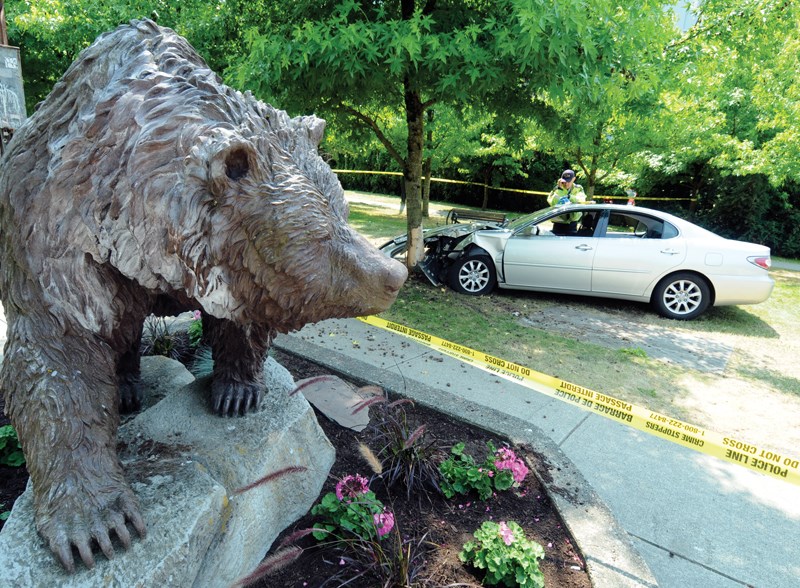I’d like to touch upon an accident that happened on July 17 right here on the North Shore.
As reported in this newspaper, two North Vancouver residents were sitting on a bench in the plaza at Lonsdale and 11th Street when they were both hit by a car.
The car in question – a gold Lexus E350, judging by the photos – was driven by a West Vancouver man in his 80s. According to reports, the attending police believe the driver wasn’t some scofflaw, but was in medical distress immediately before he swerved into the park.
Have we read this story before? It seems not all that long since I remember reading about someone seriously injured or killed when an older driver mistook the accelerator for the brake, and ran over someone in Ambleside. As I recall, the driver in that case was in his early 90s.
Now, already several people have pushed back their kitchen chairs and gone to go get a stamp so they can write (possibly several) letters complaining about ageism. It is not my intent to suggest that we should start taking licences away from anyone based simply on age. The example I always pull up here is 84-year-old racing school owner Bob Bondurant, who can still whip many a young hotshoe’s butt around a racetrack.
However, just as not every young person is an irresponsible nitwit – though there are certainly plenty of irresponsible young nitwits out there – there are plenty of older drivers out there that perhaps shouldn’t be. And further, what if there’s no way to tell that they shouldn’t be on the road? What if, undiscovered at the usual routine physical, there’s a stroke or a heart attack just waiting to send a car careening into a curb or park?
Driving is a privilege, rather than a right. However, even in a city with good access to public transport, mobility is incredibly important for older people. It represents just what it did in their youth: freedom and independence.
Thus, there’s got to be a little sensitivity whenever anyone suggests a policy for screening older drivers, or coming up with licensing restrictions. I’ve suggested in the past that, on a voluntary basis, we could adopt the Japanese system where senior drivers display a discreet badge so that other road users know to back off and give a little extra space.
Let’s leave the people side of things out of it. One area where absolutely no level of sensitivity needs to be displayed is with regards to our cars themselves. And here’s the meat of the issue: if the 80-year-old man at the beginning of this column had been driving a brand new Toyota Camry instead of an older Lexus, the two people sitting on the bench would likely not have had a car come flying in to ruin their rest.
Unlike many other manufacturers, Toyota’s suite of driver assists is standard issue on even their compact cars. It should proliferate throughout the Toyota range as models changeover, but starting right now you get it on the Corolla, Camry, and so forth.
The cynical side of me says this might have something to do with that whole unintended acceleration thing, but whatever the case, the additional equipment is good news for consumers. Toyota is careful to phrase things in a way that collision will be mitigated rather than completely avoided, but the effect is the same. If you buy a new Corolla, it’s now reasonably difficult to crash it into someone or something.
There are all sorts of other similar driver assists on the market, including from luxury marques like Volvo or mainstream North Shore favourites like Subaru. Often, such things are an optional extra.
Let’s talk about optional extras for a moment. I was flipping through an old MG magazine last week (how do they get even the magazines to leak oil? Amazing!), and came across multiple ads for aftermarket seatbelt upgrades. Added safety has been pitched to the consumer as worth the money for ages.
In the showroom, people will choose paying for convenience before paying before extra safety, especially where driver aids like lane-departure are concerned. “I can stay in my lane,” says the driver, “Why would I spend money on something that beeps at me?”
Why indeed. And there’s the old adage of: why buy something extra to go wrong? Thus manufacturers often bundle their camera systems with extra convenience features like automatic cruise control, the better to sell the sizzle with the steak.
I like Toyota’s approach even better, and think it’s about as important as the invention of the three-point seatbelt. I would prefer that you paid attention on the road. I would prefer that you gave up your licence if you started to feel unsafe behind the wheel. I would prefer that you didn’t even have a single drink before climbing into the driver’s seat and joining me and my other fellow travellers on the road.
However, I know that’s not always going to be the case. A fully autonomous driving future may take years to get here, but as for a right now solution for an aging population behind the wheel, things seem pretty straightforward. If you’re buying your “last” car, the one that’s going to run out your driving career, consider making sure it’s got that added level of safety just in case. You don’t want to hurt anyone.



